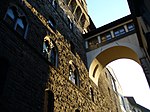Santa Felicita, Florence

Santa Felicita (Church of St Felicity) is a Roman Catholic church in Florence, region of Tuscany, Italy, probably the oldest in the city after San Lorenzo. In the 2nd century, Syrian Greek merchants settled in the area south of the Arno and are thought to have brought Christianity to the region. The first church on the site was probably built in the late 4th century or early 5th century and was dedicated to Saint Felicity of Rome. A new church was built in the 11th century and the current church largely dates from 1736–1739, under design by Ferdinando Ruggieri, who turned it into a one nave edifice. The monastery was suppressed under the Napoleonic occupation of 1808–1810. The Vasari Corridor passes through the façade of this church and on the inside there is large window, covered by a thick gate, where the Grand Dukes of the Medici family used to listen to the mass without being seen by the people staying at ground level.
Excerpt from the Wikipedia article Santa Felicita, Florence (License: CC BY-SA 3.0, Authors, Images).Santa Felicita, Florence
Via Stracciatella, Florence Quartiere 1
Geographical coordinates (GPS) Address External links Nearby Places Show on map
Geographical coordinates (GPS)
| Latitude | Longitude |
|---|---|
| N 43.766833333333 ° | E 11.252636111111 ° |
Address
Chiesa di Santa Felicita
Via Stracciatella
50125 Florence, Quartiere 1
Tuscany, Italy
Open on Google Maps










